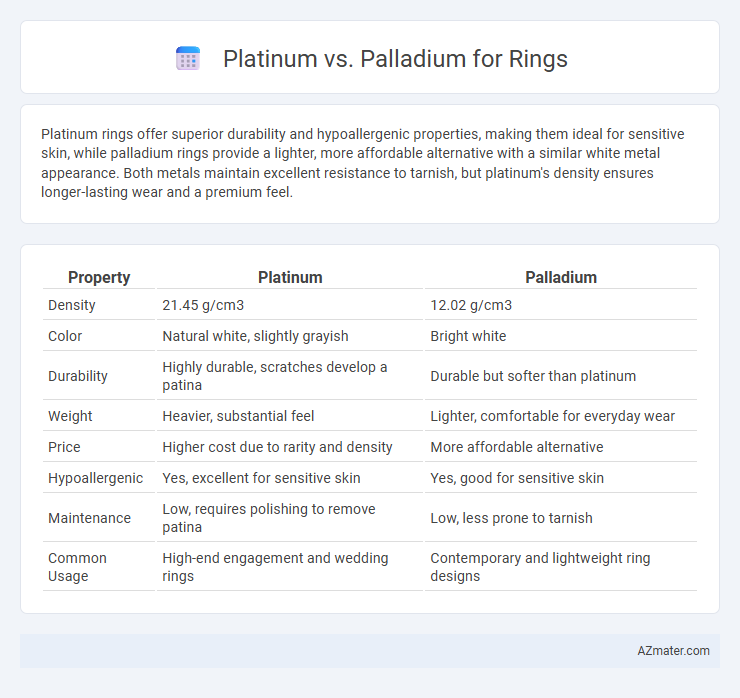Platinum rings offer superior durability and hypoallergenic properties, making them ideal for sensitive skin, while palladium rings provide a lighter, more affordable alternative with a similar white metal appearance. Both metals maintain excellent resistance to tarnish, but platinum's density ensures longer-lasting wear and a premium feel.
Table of Comparison
| Property | Platinum | Palladium |
|---|---|---|
| Density | 21.45 g/cm3 | 12.02 g/cm3 |
| Color | Natural white, slightly grayish | Bright white |
| Durability | Highly durable, scratches develop a patina | Durable but softer than platinum |
| Weight | Heavier, substantial feel | Lighter, comfortable for everyday wear |
| Price | Higher cost due to rarity and density | More affordable alternative |
| Hypoallergenic | Yes, excellent for sensitive skin | Yes, good for sensitive skin |
| Maintenance | Low, requires polishing to remove patina | Low, less prone to tarnish |
| Common Usage | High-end engagement and wedding rings | Contemporary and lightweight ring designs |
Introduction to Platinum and Palladium Rings
Platinum and palladium are both popular choices for ring metals, known for their durability and naturally white luster that enhances gemstone brilliance. Platinum rings are heavier and denser, offering exceptional strength and hypoallergenic properties, making them ideal for daily wear. Palladium rings share a similar appearance to platinum but are lighter and more affordable, appealing to those seeking a luxurious look with a lower price point.
Key Differences Between Platinum and Palladium
Platinum rings are denser and more durable, offering a naturally white, hypoallergenic metal that resists tarnish and wear over time. Palladium, a member of the platinum group metals, is lighter, less expensive, and also hypoallergenic but may require more frequent polishing to maintain its luster. The key differences lie in their weight, cost, and maintenance, making platinum ideal for long-term investment jewelry while palladium serves as a budget-friendly, low-maintenance alternative.
Appearance and Color Comparison
Platinum rings feature a naturally white, lustrous sheen that maintains its silvery-white color without fading or tarnishing over time, offering a more durable and hypoallergenic alternative. Palladium, part of the platinum group metals, has a slightly darker, grayer hue but still provides a bright, white finish that can develop a patina with wear, giving it a unique vintage appeal. Both metals are prized for their elegant appearance, but platinum's heavier density and brighter natural color make it a preferred choice for a lasting, high-end look.
Durability and Strength
Platinum offers superior durability and strength compared to palladium, making it highly resistant to scratches and wear over time. Its dense and heavy nature ensures long-lasting resilience, ideal for daily wear in rings. While palladium is also durable and lighter, it tends to scratch more easily and may require more frequent maintenance than platinum.
Weight and Comfort on the Finger
Platinum rings, known for their density at 21.45 g/cm3, feel noticeably heavier on the finger compared to palladium, which has a density of about 12.02 g/cm3, making palladium rings lighter and more comfortable for everyday wear. Despite its weight, platinum offers a luxurious, solid feel and exceptional durability, while palladium provides a similarly white sheen with less bulk, enhancing comfort without sacrificing elegance. Choosing between platinum and palladium depends largely on personal preference for either the substantial weight and lasting strength of platinum or the lightweight, hypoallergenic qualities of palladium.
Hypoallergenic Properties
Platinum and palladium are both highly valued for their hypoallergenic properties, making them ideal choices for sensitive skin in ring manufacturing. Platinum, a dense and naturally white metal, is less likely to cause allergic reactions due to its purity and resistance to tarnish, while palladium, part of the platinum group metals, offers a lightweight and affordable alternative with similar hypoallergenic qualities. Both metals rarely contain nickel, a common allergen in jewelry, ensuring comfort and durability for everyday wear.
Maintenance and Care Requirements
Platinum rings require less frequent maintenance due to their dense and durable nature, which resists scratches and tarnish, while palladium rings may need more regular polishing to maintain their luster. Palladium, being lighter and softer, can show wear faster, necessitating periodic inspections to check for damage or thinning. Both metals benefit from gentle cleaning with mild soap and water, but platinum's hypoallergenic qualities reduce the risk of skin irritation, making it ideal for sensitive skin.
Price and Market Value
Platinum rings generally command higher prices than palladium due to their rarity, density, and durability, making platinum a premium choice in fine jewelry markets. Palladium, part of the platinum group metals but more abundant and lighter, offers a cost-effective alternative with a lower market value yet comparable appearance and hypoallergenic properties. Fluctuations in global platinum and palladium prices are influenced by industrial demand, especially in automotive catalytic converters, directly impacting their availability and retail ring costs.
Popularity and Availability in Jewelry
Palladium has surged in popularity for rings due to its affordability and naturally white sheen, making it a practical alternative to platinum in fine jewelry. Platinum remains favored for its rarity, durability, and hypoallergenic properties, often seen as a symbol of prestige in engagement and wedding rings. Availability of palladium jewelry is more widespread and cost-effective, whereas platinum is less abundant and typically priced higher, reflecting its status in luxury markets.
Which Metal is Right for Your Ring?
Platinum offers exceptional durability and hypoallergenic properties, making it ideal for those seeking a long-lasting, low-maintenance ring with a naturally white luster. Palladium is lighter and more affordable while maintaining a similar white sheen, suitable for individuals wanting a stylish yet budget-friendly option without compromising on quality. Choose platinum for premium strength and prestige, or palladium for a lightweight, cost-effective alternative that still delivers elegance and resilience.

Infographic: Platinum vs Palladium for Ring
 azmater.com
azmater.com